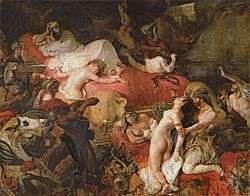Sardanapale

Sardanapalo or Sardanapale (Italian or French for Sardanapalus), S.687, is an unfinished opera by Franz Liszt based loosely on the 1821 verse play Sardanapalus by Lord Byron. As an Italian opera, it would almost certainly have been called Sardanapalo, though Liszt referred to it as Sardanapale in his French correspondence.
Background
Liszt was motivated to write a large scale opera at least partly in an attempt to be recognised as more than a travelling keyboard virtuoso.[1] (His early one-act opera, Don Sanche, could hardly qualify to raise his status.) Originally he intended to write an opera based on Byron's The Corsair, and even obtained in 1844 a libretto by Alexandre Dumas.[2] Eventually in 1845 he settled on the subject of Sardanapalus. At this time Liszt was working at the court in Weimar, but may have had his eyes on opportunities at the Hoftheater, Vienna, where the Kapellmeister, Gaetano Donizetti, was seriously ill (although he did not in fact die until 1848). A large-scale opera could have placed Liszt in the running for Donizetti's influential post, as he wrote in an 1846 letter to the Comtesse d'Agoult.[3] In correspondence with his close associate the Princess Belgiojoso, Liszt planned to have the opera performed in Milan in 1846-7.
Sardanapalus was, according to the writer Ctesias, the last king of Assyria. Some have identified him with Assurbanipal, but the Sardanapalus of Ctesias, "an effeminate debauchee, sunk in luxury and sloth, who at the last was driven to take up arms, and, after a prolonged but ineffectual resistance, avoided capture by suicide" [4] is not an identifiable historical character. Ctesias's tale (the original is lost) was preserved by Diodorus Siculus, and it is on this account that Byron based his play.
Liszt had been present at the 1830 premiere of the oratorio The Death of Sardanapalus by Hector Berlioz, which featured an immolation scene, in preparation for which a "sacrifice of the innocents" is depicted in Eugène Delacroix's sensational 1828 painting of the subject (illustration). These influences probably led Liszt to a similarly sensational concept. With reference to the inferno that ends Byron's play, he tells Belgiojoso that his finale will aim to set the entire audience alight.[5] By 1849, when he at last began to write the music, he conceived the idea of further altering the libretto by adding an orgy scene, perhaps as in Delacroix, but this was turned down by Belgiojoso.[6]
Libretto and Liszt's delay
As musicologist David Trippett argued, Liszt's first librettist, Félicien Mallefille, submitted an initial libretto too late for Liszt to consider continuing his planned collaboration with the Frenchman. An unknown contact of Belgiojoso delivered the first act of a libretto, in Italian, in 1847, with the remainder following a year thereafter. However, by 1849 he had still not written a note of the music.[7] It appears Liszt composed the first act during 1849-51.
Eventually Liszt wrote 111 pages of score (now in the Goethe- und Schiller-Archiv in Weimar) and wrote to Richard Wagner that it would be ready for production on Paris or London in 1852. Soon after this he seems to have abandoned his work on the opera. The pianist Kenneth Hamilton suggests that his diffidence may have resulted from reading Wagner's essay Opera and Drama, by whose standards Sardanapalo could have appeared somewhat dated.[8] Trippett has argued this was unlikely to have been a decisive factor, and suggested instead that Liszt's abandonment resulted from his concern over the libretto, and the fact that he never received a revised libretto for Acts 2 and 3, so could not set these to music.[9]
Planned edition
In 2016, musicologist David Trippett discovered that the music and libretto are both decipherable and continuous, constituting the first act of Liszt's planned three-act opera.[10] [11] [12] The resulting edition of what survives from Liszt's manuscript is to be published in 2019. [13] [14] No music or libretto text is known to exist for Acts 2-3.
Sources
- Kenneth Hamilton, "Not with a bang but a whimper: The death of Liszt's 'Sardanapale' ", Cambridge Opera Journal 8/1 (1996), 45-58
- Kenneth Hamilton, "Elective affinities: Wagner and Liszt", in Richard Wagner and his World, ed. Thomas S. Grey, Princeton (2009), 27-64
- Daniel Ollivier, Correspondence de Liszt et de la Comtesse d'Agoult, Paris, 1933-4.
- David Trippett, "An Uncrossable Rubicon: Liszt's Sardanapalo Revisited," Journal of the Royal Music Association 143 (2018), 361-432.
Notes
- ↑ Hamilton (1996) 46-7
- ↑ Hamilton (1996) 48
- ↑ Ollivier, (1934), II 209
- ↑ E. H. Coleridge, in his notes on Byron
- ↑ David Trippett (2018), 385
- ↑ Hamilton (1996) 54
- ↑ Hamilton (1996) 53
- ↑ Hamilton (2009) 32-33
- ↑ Trippett (2018)
- ↑ https://www.nytimes.com/2017/03/06/arts/music/listen-to-part-of-long-lost-liszt-opera-sardanapalo.html
- ↑ https://www.thetimes.co.uk/article/liszt-s-lost-opera-is-deciphered-at-last-from-a-jumble-of-notes-h6fxmbhqr
- ↑ http://www.cam.ac.uk/research/news/abandoned-liszt-opera-finally-brought-to-life-170-years-later
- ↑ http://www.emb.hu/campaign/Sardanapalo
- ↑ David Trippett website